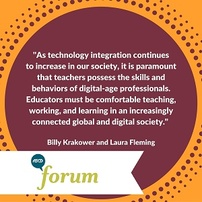 This post is a part of the conversation around the ASCD Forum “Learning for All = Teaching for All.” To learn more about the forum, go to www.ascd.org/ascdforum. By Billy Krakower and Laura Fleming We are living in a time where content is ubiquitous. Learning today can happen anytime and anywhere—on the job, in the community, or online. The world is your platform. Technology and digital learning have enhanced learning opportunities for educators by expanding access to information and resources. With less emphasis on “sit and get,” the changing landscape in the world of professional learning has ensured that educators can take shared ownership and responsibility for their professional growth. And 24/7 access to collaborative tools, online communities of practice, and resources has ensured that professional growth is no longer limited to the hours of the school day. Professional learning opportunities that are diverse, customizable, and supported by the latest technologies support learning for all. Twenty-first century educators can choose what they want to learn, the way in which they want to learn, and when they want to learn. These principles are what the Edcamp “unconference” model is built upon. Edcamps have become a popular means for professional learning. These do-it-yourself events provide educators with opportunities to share best practices, either during sessions or over informal lunch conversations. Edcamps are highly successful because they are learner driven—learners can pick and choose what they want to do and learn. Much like what we want for our students, educators are now able to create their own professional learning paths. Through digital badging platforms, educators can learn what and when they want and then receive appropriate and authoritative credit upon demonstrating their learning. Digital badges in professional learning can be a powerful way to build and communicate reputation. By leveraging the latest in social media, digital badges can be used to tell a complete story of one’s professional learning for others to see. As technology integration continues to increase in our society, it is paramount that teachers possess the skills and behaviors of digital-age professionals. Educators must be comfortable teaching, working, and learning in an increasingly connected global and digital society. Self-directed professional learning opportunities have allowed educators to take responsibility for their own growth. Modeling these practices and being transparent with their own learning can serve as a model for the kinds of learning experiences they want to bring to their students. *** Billy Krakower is a computer technology instructor and gifted and talented teacher at Beatrice Gilmore Elementary School in the Woodland Park Public School District in New Jersey. Krakower is an ASCD Emerging Leader, an author, and one of the moderators of #satchat and #njed. Connect with him on his website or on Twitter @wkrakower. Laura Fleming is a library media specialist at New Milford High School in New Milford, N.J. Fleming is the recipient of the National School Boards Association’s “20 to Watch” in educational technology leadership and the author of Worlds of Making: Best Practices for Establishing a Makerspace for Your School. Connect with her on her website or on Twitter @LFlemingEDU.
0 Comments
|
Archives
June 2018
Categories
All
|
 RSS Feed
RSS Feed